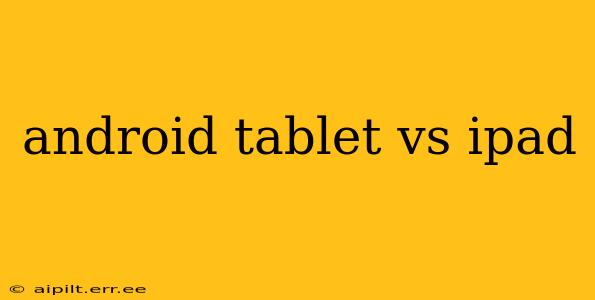Choosing between an Android tablet and an iPad can feel like navigating a complex maze. Both offer sleek designs and powerful functionalities, but their underlying operating systems, app ecosystems, and overall user experiences differ significantly. This comprehensive comparison delves into the key aspects to help you make an informed decision.
What are the key differences between Android tablets and iPads?
The core distinction lies in their operating systems: Android and iPadOS, respectively. iPadOS, built by Apple, is known for its intuitive user interface and seamless integration within the Apple ecosystem. Android, developed by Google, offers a more customizable experience with a wider range of hardware options from various manufacturers. This fundamental difference impacts almost every aspect of the tablet experience, from app availability to pricing.
What is the best tablet for drawing?
The "best" tablet for drawing depends heavily on your budget and preferred software. Both Android and iPad offer excellent options for digital artists. iPads, particularly those with Apple Pencil support, often boast superior pressure sensitivity and latency, leading to a more natural drawing experience. However, many Android tablets, especially those from Samsung with S Pen support, are catching up rapidly, offering increasingly refined stylus experiences at more competitive price points. Ultimately, hands-on testing is recommended to determine your personal preference.
Is an Android tablet good for productivity?
Yes, Android tablets can be excellent for productivity, especially when coupled with a Bluetooth keyboard and mouse. While the iPad's iPadOS is often praised for its productivity features, Android tablets offer flexibility through multitasking capabilities and access to various productivity apps like Microsoft Office, Google Workspace, and others. The choice often depends on your preferred workflow and existing software ecosystem.
Which is better for gaming: Android or iPad?
The gaming landscape on both platforms is robust. Android tablets, particularly those with higher-end processors, often offer a wider selection of games, including many available through the Google Play Store that aren't on the App Store. However, iPads consistently provide a polished and optimized gaming experience thanks to their consistent hardware and software integration. The "better" choice depends on your preferred gaming titles and priorities (e.g., graphic fidelity vs. game selection).
Which tablet has better apps?
This is a complex question without a single definitive answer. The Apple App Store boasts a reputation for curated apps with often higher quality standards. However, the Google Play Store offers a far broader selection of apps, including many niche or regionally specific applications. The "better" app ecosystem depends entirely on your individual needs and app preferences. If your essential apps are available on both platforms, the difference may be negligible.
Which is cheaper: an Android tablet or an iPad?
Generally, Android tablets offer a wider range of price points, with many budget-friendly options available. iPads tend to sit at the higher end of the price spectrum. This price difference is largely due to the brand recognition, hardware quality control, and the overall ecosystem that Apple maintains.
How do Android tablets compare to iPads in terms of security?
Both Apple and Google prioritize security in their respective operating systems. Apple's tightly controlled ecosystem and regular software updates offer a strong security posture. Android's open nature requires diligence in keeping the software updated and choosing reputable app sources. While both are secure, the approach and inherent vulnerabilities differ; therefore, it’s important to be informed about potential risks on both platforms.
Conclusion: Android Tablet vs. iPad – The Verdict
The "best" tablet – Android or iPad – depends entirely on individual priorities and needs. iPads generally excel in design, ecosystem integration, and user experience, but often come at a premium price. Android tablets provide greater hardware flexibility, affordability, and app diversity. Carefully weigh the factors discussed above—budget, preferred apps, productivity requirements, and gaming preferences—to determine the tablet that best fits your lifestyle and technological needs.
